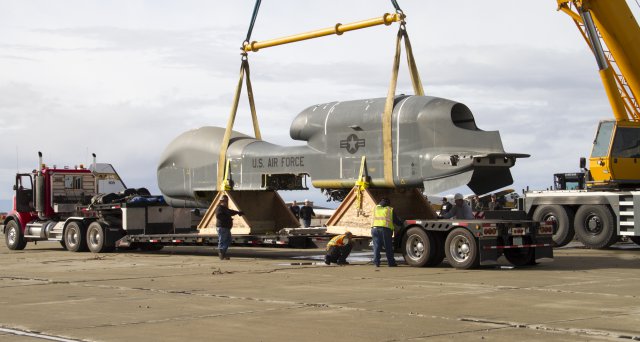 During a flight in May 2009, an Edwards RQ-4B Global Hawk Block 20 remotely piloted aircraft (tail number 2016) encountered a complete spoiler communication loss and had to execute an emergency landing on the dry lake bed at Edwards Air Force Base. During landing, the aircraft sustained major damage to the right main landing gear and wing when it struck a precision approach path indicator light.
During a flight in May 2009, an Edwards RQ-4B Global Hawk Block 20 remotely piloted aircraft (tail number 2016) encountered a complete spoiler communication loss and had to execute an emergency landing on the dry lake bed at Edwards Air Force Base. During landing, the aircraft sustained major damage to the right main landing gear and wing when it struck a precision approach path indicator light.
At the time, the damage sustained by T/N 2016 was too costly for the Global Hawk System Program Office to repair, so the air vehicle was stored until a final disposition could be made about its future. Nearly six years later this month, the Navy and Air Force collaborated on the resurrection of this Global Hawk for static training purposes.
“In early 2013, the United States Navy propositioned Global Hawk’s System Program Office for transfer of T/N 2016 to the Persistent Maritime Unmanned Aircraft Systems Program Office (PMA-262) located at [Naval Air Station] Patuxent River, Md., to be used in MQ-4C Triton device development and maintenance training,” said Julie Cagle, 412th Test Support Squadron program manager. “In August 2013, T/N 2016 was declared excess by the Air Force and the GH director agreed to transfer T/N 2016 as a donation to the U.S. Navy to aid in the overall device and training development of the programme.”
According to Cagle, the MQ-4C Triton is a variant of the RQ-4B Global Hawk and is built by Northrop Grumman for the Navy’s Broad Area Maritime Surveillance program. She also mentioned the MQ-4C Triton would be specifically used for maritime surveillance.
“In return for the RPA, the Navy agreed to transfer all training device specifications, maintenance curriculum, and test data to the GH System Program Office. This arrangement allows shared knowledge across programs,” Cagle said.
Actual transfer of the air vehicle components to the truck trailers was accomplished March 1, where the operation began at 7 a.m. and ended with successful escort to the Edwards “West Wall” entrance marker at 12:40 p.m., to mitigate for traffic disruptions to the base population, according to Cagle.
“The Global Vigilance Combined Test Force was tasked by the GH SPO to collaborate with the Navy for physical transfer of T/N 2016. The GV CTF acquired all the necessary equipment to help dismantle [T/N 2016] for transport, as well as, equipment to transfer the dismantled parts – wing without extensions, fuselage, and V-tail components – to the transports,” Cagle said. “The GV CTF also coordinated escort off of Edwards via the West Gate through the required support organizations.”
From there, Cagle noted that the RPA was dismantled and transferred to the transports over a period of five days, Feb. 25 to March 1.
“The V-tails and wing were fully removed from the fuselage for transport. The air vehicle components required three trucks for transport. The V-tails and fuselage were shipped on standard 53-foot truck trailers and the wing was transported on a specialized trailer that was capable of extending to 125 feet to accommodate the Global Hawk wing,” said Cagle.
“Honestly, this effort was no small feat even though our team was able to make it look easy. The effort required significant collaboration from external organizations to be successful, specifically the maintenance organization that provided equipment support to the Navy and the security police who escorted the convoy off the base,” added Cagle. “The execution was flawless, but only because of the caliber of the individuals we are fortunate to work with here at Edwards.”
Source: US Air Force
